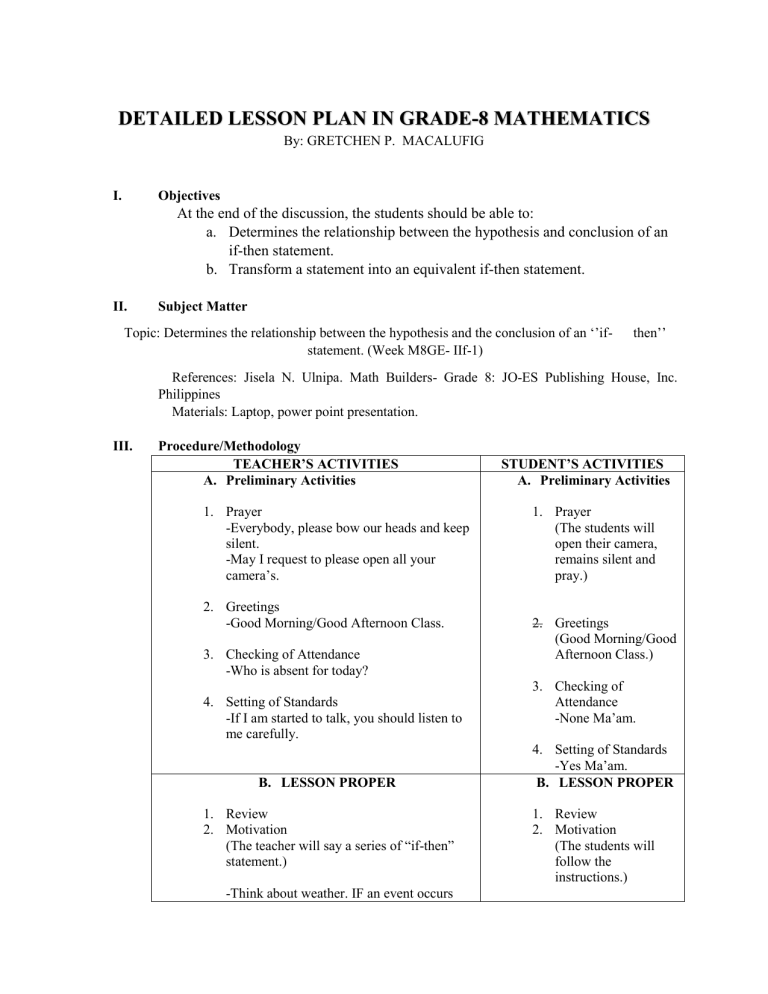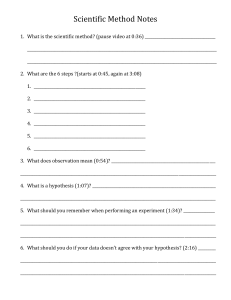
DETAILED LESSON PLAN IN GRADE-8 MATHEMATICS By: GRETCHEN P. MACALUFIG I. Objectives At the end of the discussion, the students should be able to: a. Determines the relationship between the hypothesis and conclusion of an if-then statement. b. Transform a statement into an equivalent if-then statement. II. Subject Matter Topic: Determines the relationship between the hypothesis and the conclusion of an ‘’ifstatement. (Week M8GE- IIf-1) then’’ References: Jisela N. Ulnipa. Math Builders- Grade 8: JO-ES Publishing House, Inc. Philippines Materials: Laptop, power point presentation. III. Procedure/Methodology TEACHER’S ACTIVITIES A. Preliminary Activities 1. Prayer -Everybody, please bow our heads and keep silent. -May I request to please open all your camera’s. 2. Greetings -Good Morning/Good Afternoon Class. 3. Checking of Attendance -Who is absent for today? 4. Setting of Standards -If I am started to talk, you should listen to me carefully. B. LESSON PROPER 1. Review 2. Motivation (The teacher will say a series of “if-then” statement.) -Think about weather. IF an event occurs STUDENT’S ACTIVITIES A. Preliminary Activities 1. Prayer (The students will open their camera, remains silent and pray.) 2. Greetings (Good Morning/Good Afternoon Class.) 3. Checking of Attendance -None Ma’am. 4. Setting of Standards -Yes Ma’am. B. LESSON PROPER 1. Review 2. Motivation (The students will follow the instructions.) THEN what happens? IF it is hot, THEN wear_________. IF it is cold, THEN wear________. IF it is rainy, THEN wear________. -a sando and short. -a jacket and pajama. -a raincoat and boots. -Think about the school day. IF an event occurs THEN what happens? IF it is Math class, THEN ________. IF it is library day, THEN ________. - do solving problems. IF the teacher is talking, THEN ___. C. Activity -research about the given projects given by the teachers. -keep silent and listen carefully. C. Activity -Before we proceed to our discussion, let’s have first an activity. -I will flash some statements. All you need to do is to identify the underlined statement whether it is hypothesis or conclusion. -Write P If the underlined statement is hypothesis and Q if it is conclusion. -I’ll give you 1 minute on each statements to complete and type your answer on the comment section below. -Is that clear? (The teacher will flash the statements.) -Yes Ma’am. D. Analysis -What did you do in the given activity? -What have you noticed to the given statement? -Can you now identify what is the hypothesis and conclusion? E. Abstraction (The students will answer the following statements.) D. Analysis -We identify the underlined statement whether it is hypothesis or conclusion. -The statement we answered is an example of the hypothesis and the conclusion. -Yes Ma’am. E. Abstraction -From the given activity you’ve just encountered, the hypothesis and the conclusion or the “if-then” statements. -You are already familiar with the concept of this in your daily lives. -Have you ever had a parent say any of the following… “If you clean your room, then you can go out with your friends.” “If your module is done, then you can play with your mobile phone.” “If you do your chores all week, then you can get your allowance.” - Those are an example of the hypothesis and the conclusion or the “if-then” statements. - These statements is composed of two (2) clauses. From the given examples, what do you think is the two clauses? - Very well said. - The if-clause is the hypothesis and the thenclause is the conclusion. - We can denote a letter for each clause, p for the if-clause or the hypothesis and q for thenclause or the conclusion. - The statement is in the form, “If p then q.” or “p implies q.” -Example, If you clean your room, then you can go out with your friends. -What do you think is our hypothesis (p)? - How about the conclusion (q)? - Very good. - The measure of an acute angle is between 0 and 90. We can write the statement in the ifthen form. If the angle is acute, then its measures is between 0 and 90. -Try to answer this example -Two distinct planes intersect. -The intersection is a line -Yes Ma’am. -I think the two clauses are the ifclause and the then-clause. -You clean your room. -You can go out with your friends. - Since you’ve already identified and determine the relationship of the hypothesis and conclusion. -If two distinct planes intersect, then their intersection is a line. F. Generalization -I know you’ve learned a lot from this F. Generalization (Students will raise their discussion, so anyone who can summarize the Lesson? (Call two students to generalize the topics.) hands) Very good. Are they any question? What is hypothesis means? Very good. How about the conclusion? Very good. You all did understand the lesson. -what are you feeling right now? -kindly use our in call messages on what you are feeling right now -if you are happy kindly sent a “happy emoji , if you are feeling loved sent a “heart emoji” G. Application -I will group you in to four (4) groups. -I will flash some statements. Each groups should be identify the hypothesis and the conclusion of each statements. -Each group should have one representatives. The representative will discuss the given statements belong. IV. Evaluation In any sheet of paper, write the hypothesis and conclusion of an “if-then” statements. 1. If two planes intersect, then their intersection is a line. Hypothesis: ________________________________ ___ Conclusion: ________________________________ ___ (None Ma’am) -It states the given facts that are assumed to be true. -What needs to be proven or established. -(students will sent a different emojis) G. Application (The students will listen to the instruction.) 2. If today is Monday, then tomorrow is Tuesday. Hypothesis: ___________________________ Conclusion: ___________________________ 3. If two angles are congruent, then they are vertical. Hypothesis: ___________________________ Conclusion: ___________________________ 4. If a number is a whole number, then it is an integer. Hypothesis: _______________________________ Conclusion: _______________________________ 5. If a number is an integer, then it is a rational number. Hypothesis: ______________________________ Conclusion: ______________________________ V. 1. 2. 3. 4. 5. Assignment Identify the Hypothesis and the Conclusion in the following statements: If a polynomial has six sides, then it is a hexagon. If a figure is a triangle, then it has three angles. If 3x = 24, then x = 8. If two angles are congruent, then they are vertical. If two lines are skew, then they do not intersect.




